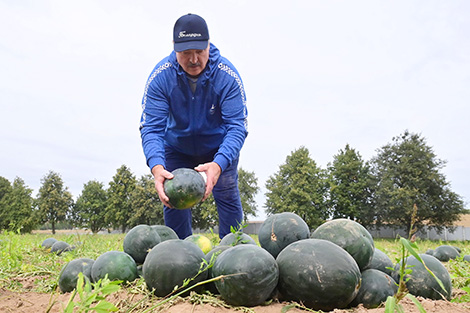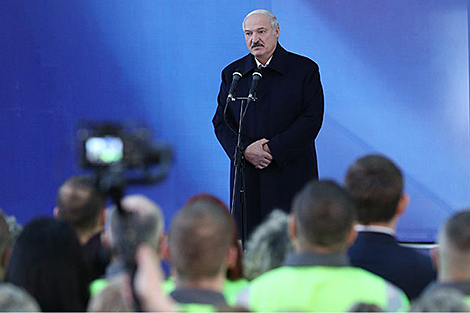News & Events in Belarus
Lukashenko encourages farmers to venture into new crops

In July 2022, many housewives took note of the salad recipe from the president. Simple, fast and healthy. It helps to restore strength after hard physical work or illness. Green onion leaves were used by the ancient Romans and Greeks. For example, about 150 grams of green leaves will meet your daily Vitamin C needs. Today it is difficult to imagine but a few decades ago Belarus used to import onions. In the latest episode of BelTA’s YouTube channel “After the Fact: Lukashenko’s Decisions” we will tell you how many varieties of onions are grown in Belarus. How do farmers experiment with asparagus and artichokes, which are new crops for Belarus? What areas in the country are allocated for hazelnuts and walnuts?
When did Belarus begin to grow onions on an industrial scale?
Belarus began cultivating onions on an industrial scale about 20 years ago. It started with small volumes. For example, in 2004, only 20,000t were grown in the country. A year later it was 50,000t. At that time, we were just learning to work with this crop. After all, the food industry needed this vegetable. The country imported tens of thousands of tonnes of onions from southern countries. At that time, the word "import substitution" was not as trendy as it is now. But the point is the same: we need to learn to produce as much as possible domestically!
“I always remember this example. We used to buy onions abroad. There was this guy. Popkov was his last name. We were somewhere in a field, I asked a question about the onions. He said that Gomel Oblast can meet the country’s needs. Me: “What do you need for this?” He asked for some moderate funds. Today, the country is self-sufficient in this vegetable. It all started with you,” the head of state at the Dazhynki 2024 harvest festival in the town of Korma in Gomel Oblast.

In 2005, Gomel Oblast accounted for a half of the national onion production. Valery Popkov's textbook "Onions in Belarus: from planting to harvesting" has become a desk book for all vegetable growers.
“Scientists together with manufacturers have worked out the technology for growing onions, from seeds to a summer crop. At the moment, the production of onions exceeds 30,000t annually, which fully meets the needs of Belarusians in marketable onions,” said Nikolai Leshik, the head of the Main Department of Crop Production with the Agriculture and Food Ministry of Belarus.

Belarus’ major onion producers
Today, the vegetable is grown in all regions of the country. But the leaders are the southern regions: Gomel Oblast and Brest Oblast, with 17,000t each. This is due to the warmer climate. Part of the harvest goes into the stabilization stocks. Delivery schedules to retail chains are drawn up to make sure there is no shortage of domestic onions on store shelves in the off-season.
“In general, there are about a hundred varieties and hybrids on the varieties and hybrids register. All hybrid varieties have successfully passed state variety trials, showed good results, and their use is allowed in Belarus,” Nikolai Leshik noted.

The climate is changing. In general, it has become warmer. According to the forecasts of Belarusian scientists, in 5 to 10 years the temperature in Vitebsk Oblast will be approximately the same as in Polesie. The length of seasons changes. Winters are getting shorter and summers are getting longer. All this has an impact on agriculture.
“We need to produce new crops that we import from abroad, that our people need and that we can sell on foreign markets,” Aleksandr Lukashenko said at the Dazhynki festival in Korma.

He noted that Gomel Oblast is successfully cultivating fruits, vegetables, berries. It produces up to 45% of the country’s peas output, a quarter of the onion and almost 100% of asparagus beans. “Work is underway, but we need to speed it up. If we fall behind, those who follow will knock us down from the market,” the president said.
Farmers’ opinion on asparagus and artichoke
Farmers Natalia and Andrei Kravchuk were among the first in Belarus to start growing asparagus. The family lives in the south of the country, in Brest Oblast. They say that they began to cultivate this relatively new crop for Belarus not at the call of the heart, but by calculation: as a result of market monitoring. The demand for this premium product in the country is growing. No wonder. Modern people are more health conscious. Asparagus is low in calories, high in fiber, and rich in microelements. By the way, asparagus is a close relative of onion.
“Spring begins when you want something green. At first, it is onion green leaves, radish, and then asparagus,” Andrei Kravchuk said.

His wife believes that asparagus can be called a superfood. “It is very rich in microelements and vitamins. In spring, you crave for it. Because our body asks to make up for vitamin deficiency,” Natalia said.
So far, not all Belarusians have appreciated the benefits of asparagus. In retail chains, it is sold with varying success. Therefore, not many take up on this crop. There is also a question with crop storage.
“Storage of fresh produce is an issue for the time being. If we talk about extended delivery period, we mean frozen or canned products. But when there is a continuous demand, agricultural producers quickly respond and increase the output of the products that are marginal, which are in demand,” Nikolai Leshik said.
Artichokes are another experiment of the Kravchuk family. This year, thanks to the warm autumn, they collected the second harvest of this crop... in October. Artichoke is not yet as popular in Belarus as asparagus, but gastro enthusiasts have already appreciated the experiment. This crop sells well.

“It is a heat-loving, frost-sensitive plant. We are still gaining experience of cultivating it. August has been a very hot month over the past two years. September is warm too. Winter comes late. Winters are rather warm in Belarus,” Andrei Kravchuk said.
What crops are on trend in Belarusian farms
Another gastronomic trend is the cultivation of hazelnuts and walnuts. These crops are not new for Belarus. They are actually the forgotten old ones. These products are in high demand. Producers are trying to carve out this niche. Hazelnuts in Belarus ripen in September. Southern countries have them ready in summer. In fact, this is a cultivated hazelnut.
Today the main hazelnut producing countries are Azerbaijan, Georgia and Türkiye. The product is mostly used in confectionery and retail trade. One hectare of hazelnut plantation can earn up to $10,000. Walnuts are also in demand. Much has been said about its useful properties. Belarus cultivates several types of walnuts.

“In general, there are more than 700 hectares planted with hazelnuts and walnuts across the country. The gardens were laid down some 4 to 5 years ago. They are coming into fruiting and I believe that in the near future the share of Belarus-made nuts in our retail will increase,” Nikolai Leshik said.
Farmers are mobile and ready to experiment. There is a vegetable, which the country still imports. We need to do our best to grow it ourselves. The president was shown the results of the Chinese cabbage growing experiment during his visit to Molodechno District in September.

Belarusians are also trying their hand in growing grapes. The southern regions - Brest Oblast and Gomel Oblast - are leaders here again. There are farms that have planted two hectares of vineyards each. Collection material is kept at the Institute of Fruit Growing in Samokhvalovichi.
“Unfortunately, grapes cannot be cultivated evenly across the country. Our climate does not make it possible to produce the berry as strong and tasty as the former Soviet or CIS countries get. There are also apricot and peach plantings. They are also insignificant. What is the reason? Probably, our breeders have not yet worked out the material to ensure stable overwintering and high yields,” Nikolai Leshik added.
How climate change affects Belarusian agriculture
Late frosts are of particular danger. They may strike in May, and sometimes even in June. They result in the loss of the harvest of heat-loving plants.
During his working trip to Gomel Oblast in February 2020, the president talked to the employees of the plant producing bleached sulphate pulp at Svetlogorsk Pulp and Paper Mill, answered a question about climate change, which has obviously affected Belarus as well.
“We succeed somewhere. We may lose somewhere at first, if we do not act fast,” the Belarusian leader said. “Today it is absolutely clear, especially to you, Gomel residents, that the climate has changed dramatically. Today you already live in a climate zone south of Kiev.”

Aleksandr Lukashenko added that he had discussed the issue with the Gomel Oblast governor and asked him to decide on what to do in agriculture due to climate change and what crops to cultivate. “You should take what we have already tested and cultivate it here, in Gomel Oblast,” the Belarusian leader stressed.
The president added that he also cultivated such unusual crops as watermelons in his garden. The head of state also cultivates many traditional crops, such as potatoes, and distributes among various institutions. “We got 300 tonnes of potatoes on a small plot of five hectares. We have given it away. The harvest will be taken to a monastery. We give it to people. We also give away seeds because these are new varieties. I do it as a hobby. I like looking for new varieties,” the head of state said.
Why Lukashenko is confident that import substitution is crucial for food security
Maize is called the queen of the fields. This crop, however, is heat-loving, too. Cultivating it in the northeastern regions used to be a risky business. Scientists have developed more cold-resistant hybrids. Today maize is produced in Vitebsk Oblast and Mogilev Oblast. This is a matter of both climate change and the work of scientists. Although there are still problems to be addressed in this area.
At a meeting with the Council of Ministers in January 2024 the head of state cited an example McDonald's that ceased its operation in the country and expressed confidence that Belarus could and should engage in import substitution in the segments abandoned by investors from unfriendly countries due to sanctions. The Belarusian leader noted that this was not only a question of import substitution as such, but also a matter of the quality of products in the country.
“This is Belarusian-made. We are responsible for its quality. We are food self-sufficient. Import substitution in food production is of utmost importance. The nation’s health depends on the quality of food. The rest is not that important. The rest we can learn. We actually do well in mechanical engineering and many other sectors,” the president stressed.







 print version
print version make home page
make home page add to bookmarks
add to bookmarks

